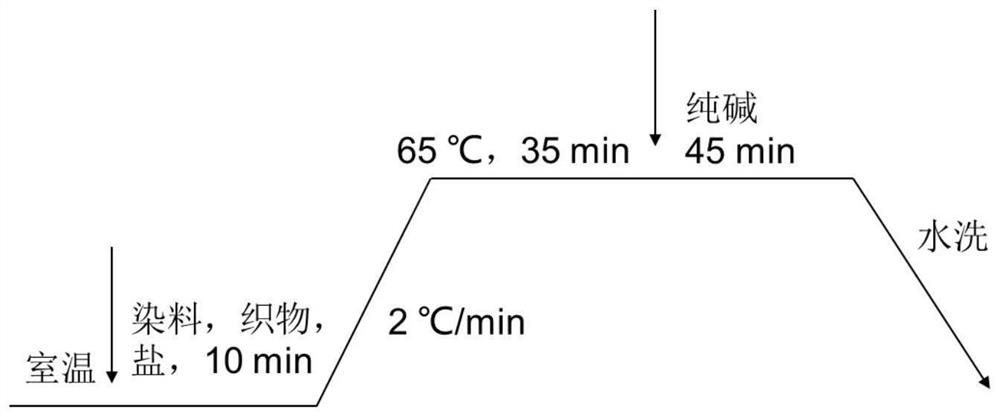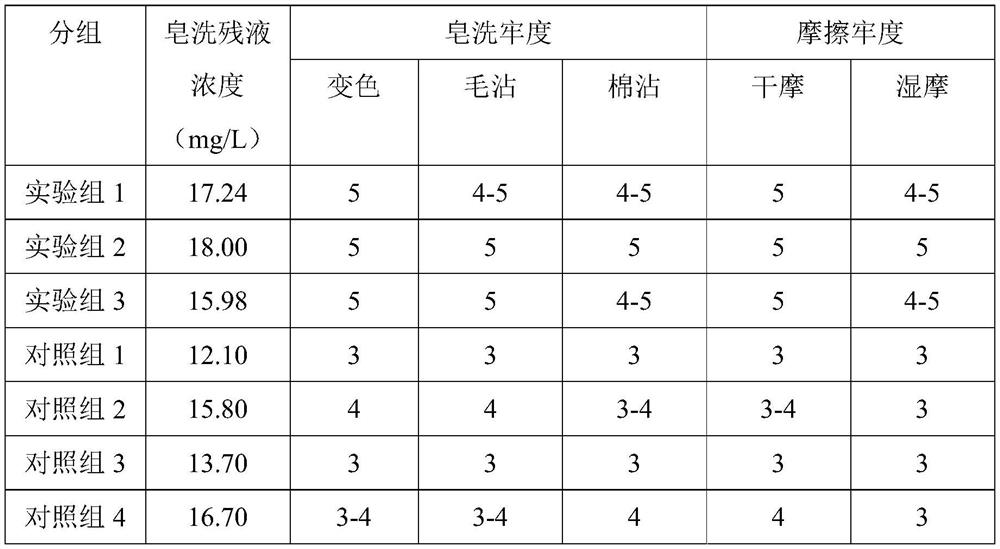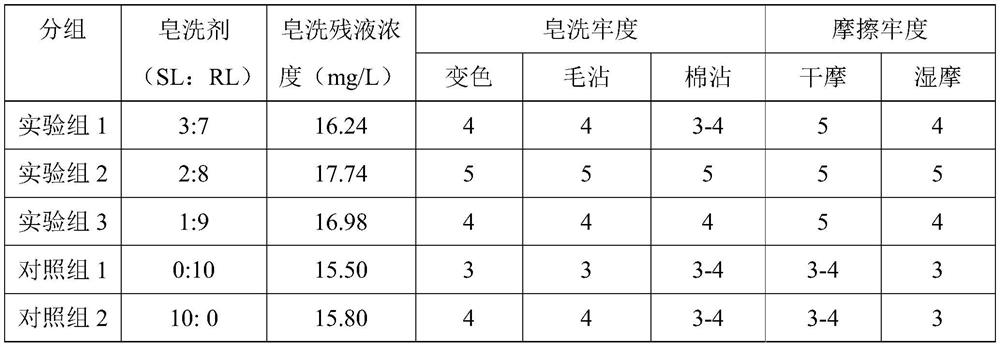Soaping agent for cotton fabric dyed with reactive dyes and its preparation method and application
A technology of soaping agent and surfactant, which is applied in the field of soaping agent and its preparation for dyed cotton fabrics with reactive dyes, can solve the problems of pollution and achieve the effect of reducing the use of water resources
- Summary
- Abstract
- Description
- Claims
- Application Information
AI Technical Summary
Problems solved by technology
Method used
Image
Examples
experiment example 1
[0046] Experimental example 1: The effect of time on the soaping effect of sophorolipids
[0047] A soaping process, the soaping process comprises hot water washing, cold water washing, soaping agent soaping, and then through the steps of cold water washing.
[0048] Wherein, the soaping agent is a sophorolipid with a mass concentration of 2 g / L.
[0049] Wherein, in the soaping step of the soaping agent: the ratio of soap to bath is 1:30, and the soaping temperature is 80°C.
[0050] Wherein, in the hot water washing step, the temperature is 55° C., the time is 5 minutes, and the bath ratio is 1:50.
[0051] Wherein, in the cold water washing step, the temperature is 25° C., the time is 5 minutes, and the bath ratio is 1:50.
[0052] According to the above soaping method, the cotton fabrics dyed with reactive dyes were soaped, and grouped according to different soaping times, wherein: the corresponding soaping times of experimental groups 1, 2, and 3 were: 15min, 20min, and...
experiment example 2
[0058] Experimental example 2: Effect of temperature on soaping effect of sophorolipids
[0059] A soaping process, the soaping process comprises hot water washing, cold water washing, soaping agent soaping, and then through the steps of cold water washing.
[0060] Wherein, the soaping agent is a sophorolipid with a mass concentration of 2.0 g / L.
[0061] Wherein, in the soaping step of the soaping agent: the ratio of soap to bath is 1:30, and the soaping time is 20 minutes.
[0062] Wherein, in the hot water washing step, the temperature is 55° C., the time is 5 minutes, and the bath ratio is 1:50.
[0063] Wherein, in the cold water washing step, the temperature is 25° C., the time is 5 minutes, and the bath ratio is 1:50.
[0064] According to the above soaping method, the cotton fabrics dyed with reactive dyes were soaped, and grouped according to different soaping temperatures, wherein: the corresponding soaping temperatures of experimental groups 1, 2, and 3 were: 60°...
experiment example 3
[0070] Experimental Example 3: Effect of Sophorolipid (SL) / Sodium Dodecylbenzene Sulfonate (SDBS) Compound System on Soaping Effect
[0071] A soaping process, the soaping process comprises hot water washing, cold water washing, soaping agent soaping, and then through the steps of cold water washing.
[0072] Wherein, the total concentration of the soaping agent system of the experimental group and the control group is 2.0 g / L.
[0073] Wherein, in the soaping step of the soaping agent: the ratio of soap to bath is 1:30, the soaping time is 20 minutes, and the soaping temperature is 80°C.
[0074] Wherein, in the hot water washing step, the temperature is 55° C., the time is 5 minutes, and the bath ratio is 1:50.
[0075] Wherein, in the cold water washing step, the temperature is 25° C., the time is 5 minutes, and the bath ratio is 1:50.
[0076] According to the above-mentioned soaping method, reactive dye dyed cotton fabric is soaped, and grouped according to different so...
PUM
| Property | Measurement | Unit |
|---|---|---|
| concentration | aaaaa | aaaaa |
Abstract
Description
Claims
Application Information
 Login to View More
Login to View More - R&D
- Intellectual Property
- Life Sciences
- Materials
- Tech Scout
- Unparalleled Data Quality
- Higher Quality Content
- 60% Fewer Hallucinations
Browse by: Latest US Patents, China's latest patents, Technical Efficacy Thesaurus, Application Domain, Technology Topic, Popular Technical Reports.
© 2025 PatSnap. All rights reserved.Legal|Privacy policy|Modern Slavery Act Transparency Statement|Sitemap|About US| Contact US: help@patsnap.com



